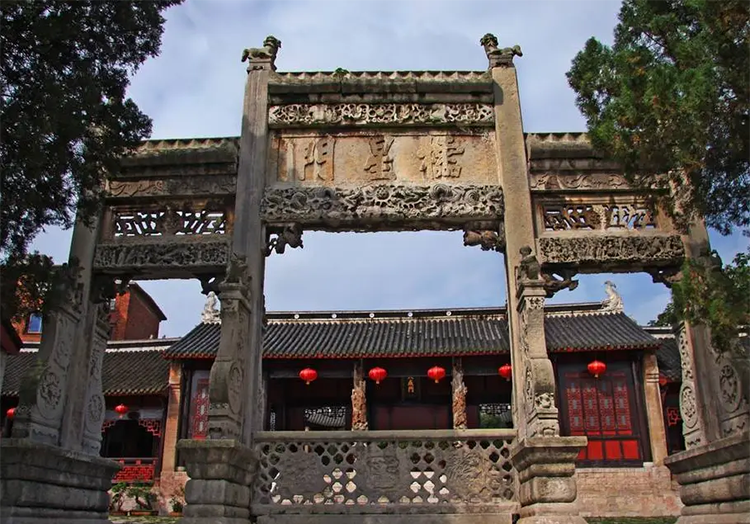Anshun Confucian Temple: Ming Dynasty Architecture at Its Finest
Introduction:
Push open the vermilion gate of Anshun Confucian Temple and you step into a six-century conversation between past and present. Sunlight filters through ancient cypress branches, casting dappled patterns on bluestone paths; carved lattice gates shift between light and shadow while faint scents of sandalwood and ink linger in the air. More than Guizhou’s best-preserved Ming-era Confucian complex, this living academy embodies the cultural credo of respecting teachers and learning. Walk its courtyards and you may hear the wind whisper across the heavy eaves — history murmuring how the southwestern frontier became a bearer of Chinese civilization.
1. Soul Imprint: A Living Fossil of Southwestern Confucianism
Anshun Confucian Temple is the largest and most intact Ming-style Confucian complex surviving in Guizhou, often hailed as the region’s primary Confucian sanctuary. Founded in the early Ming (1368, Hongwu reign) it witnessed the imperial examination system and symbolizes Central Plains culture taking root on the southwest frontier. Its unique value rests on three features: preserved Ming official architectural rules, a precious collection of Ming and Qing steles and texts, and an ongoing living tradition of Confucian rites.
2. Historical Flow: From Frontier Academy to Cultural Landmark
The temple’s origin links to Ming migration and educational policies aimed at civilizing the southwest. During the Hongwu era the court established a prefectural school in Anshun (historically Puding Wei), and the Confucian temple followed. An inscription from the Jiajing era documenting repairs and expansion declares, ‘Guizhou’s cultural education begins here,’ underlining its pioneering role. Although damaged by warfare over centuries, repeated Qing restorations preserved its Ming character. Designated a national key cultural relic in 2001, the complex now functions as a museum and active center for Confucian culture.
3. Architectural Decoding: A Three-Dimensional Treatise on Building Principles
• Central Axis and Ritual Sequence: Along an 8,000-square-meter central axis, the gate, pond, Dacheng Gate, Dacheng Hall, and Chongsheng Shrine align in strict symmetry that echoes Confucian balance. The scholar’s bridge over the pond recalls the legendary ‘leap over the dragon gate’ — many students once crossed here en route to success; the bridge’s stone carvings still imply scholarly triumph.
• Dacheng Hall Essentials: The hall’s nine-ridge, double-eaved hipped roof fans like a great bird. Its five-bay layout honors Confucius’ supreme status. Look up to find Ming-era polychrome paintings of cranes and auspicious clouds, and the distinctive ‘elephant-trunk’ bracket sets that mark Guizhou’s traditional joinery. Inside, a stern Confucius statue presides, flanked by memorial tablets of the ‘Four Attendants and Twelve Worthies’, testifying to unbroken orthodox lineage.
• Stele Gallery: Over twenty Ming and Qing steles line the corridors. A Jiajing inscription in refined regular script records the temple’s story, while a Qing Qianlong stele listing successful examination candidates recalls countless modest students who rose to national fame.

4. Immersive Experience: Touching the Confucian Spirit Through Ritual
Each morning local elders gather before Dacheng Hall to recite Analects passages; their clear voices mingle with eave bells. On the 27th day of the eighth lunar month — Confucius’ birthday — the temple stages a solemn sacrificial ceremony with participants in Hanfu performing the six-row dance ‘Liu Yi’. Visitors can join several activities:
– Incense Offering: Bow three times at the incense burner, insert incense with the left hand as a symbol of prioritizing virtue.
– Wish Plaques: Write intentions by the pond and feel the ancient blessing of ‘top of the list’ for scholars.
– Stone Rubbing: Staff guide you in taking a rub from a historic stele on rice paper — a tangible piece of history to take home.
5. Environmental Narrative: A Philosophical Courtship of Trees and Stone
The temple’s hush forms a striking contrast with the busy streets a hundred meters away. Instead of tour crowds, you find local readers, art students sketching the carvings, and families introducing children to history. Three 500-year-old ginkgo trees anchor the atmosphere: in autumn their golden leaves carpet the ground, visually echoing the Analects’ meditation on the passage of time. Sit on the Dacheng Hall platform and watch light traverse carved doors; you may suddenly grasp the meaning of ‘a gentleman guards his solitude.’
6. Itinerary Tips: A Must-Visit for Culture Lovers
– Recommended visit length: 2 hours for a thoughtful tour (add 1 hour for stele rubbing or a lecture).
– Best times: Arrive at opening, 8:30, for a near-private experience, or after 15:00 to capture dramatic late-afternoon light through the lattice gate.
– Suggested combinations:
→ Morning: Confucian Temple plus the adjacent Martial Temple to compare literary and military traditions.
→ Afternoon: Walk 10 minutes to Rulin Road, sip local Tunpu tea on the century-old stone street.
→ Cultural route: Pair with Anshun Batik Museum to explore interactions between Confucian and ethnic minority cultures.
7. Practical Guide: Courteous and Convenient Cultural Travel
– Etiquette: Remove hats inside Dacheng Hall, speak quietly, and never point at statues; turn off flash when photographing.
– Opening hours: 8:30–17:30 (last entry 16:50), open year-round.
– Tickets: 20 RMB (includes audio guide). Student discount available; mobile ticketing avoids queues.
– Getting there: Bus routes 1 or 8 to ‘Wenmiao Station,’ then a 3-minute walk east to the lattice gate. Driving: navigate to ‘Anshun Wenmiao Parking’ (5 RMB/hour; limited spaces).
– Local perk: Free guqin performances in the Chongsheng Shrine courtyard at 10:00 and 15:00 daily.

Epilogue: Encountering Civilization at a Convergence of Time
As you run a hand along the smooth stone lion on the pond railing, a line from the Book of Songs may come to mind: ‘As if cut and polished, as if carved and smoothed.’ Anshun Confucian Temple’s greatness lies not only in its preserved Ming brackets and polychrome but in its power to make each visitor a present link in cultural transmission. Before you leave, offer a deep bow at Dacheng Hall — not as a vow to a deity, but as an homage to the enduring vitality of Chinese civilization.


